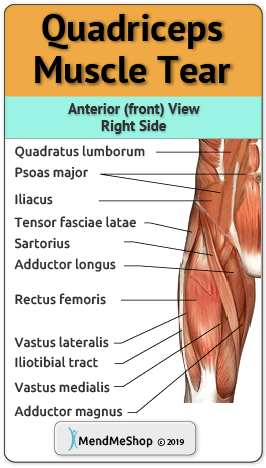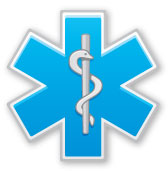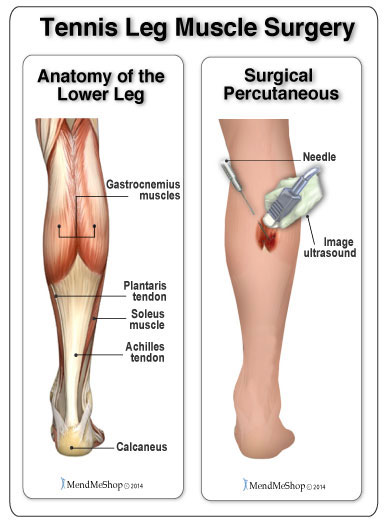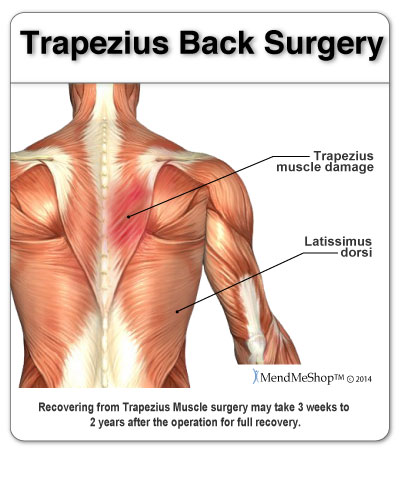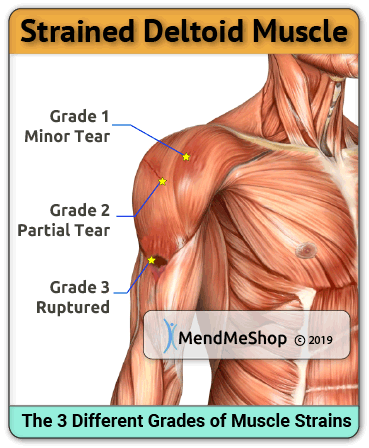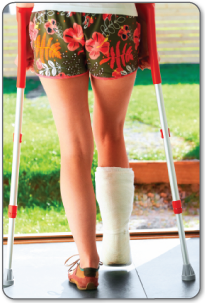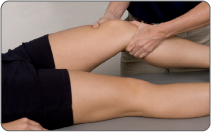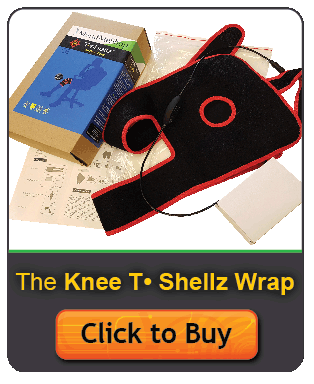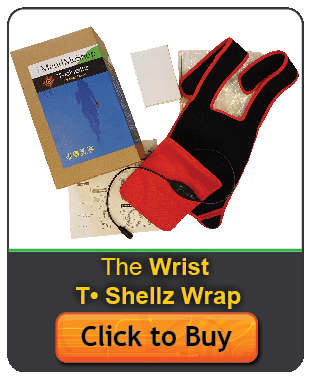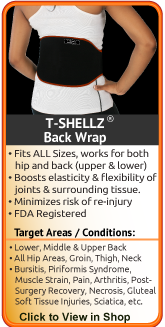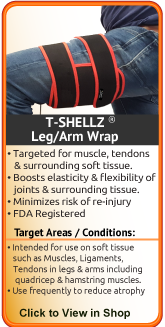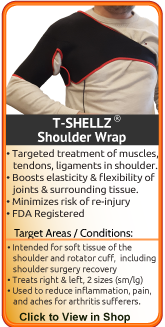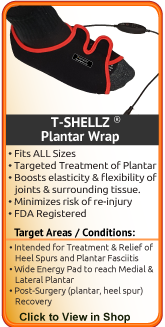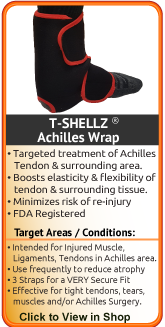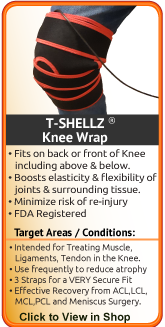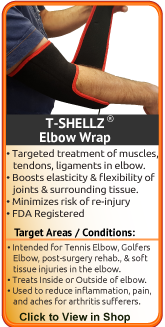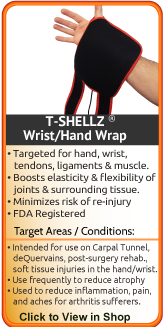Muscle Surgery and
Post-Operative Rehabilitation
Not every muscle injury or condition requires surgery.
It's generally understood by doctors and surgeons, that surgery will introduce more scar tissue into the muscle tissue. This added scar tissue will be problematic, requiring visits to a physical therapist (PT) and conservative treatment options post-surgery. If not dealt with properly, your injury could end up in worse condition than before the surgery! This is why surgery is only performed as a last resort - basically for chronic (long term) conditions, full ruptures of tendon/muscle/ligaments, arthritis, and/or severe, non-recoverable damage in a joint (ie. hip replacement due to fracture or extensive arthritis)..
Surgery on soft tissue is generally not considered until all conservative treatment options have been exhausted... or there is an infection, or a large/full tear in one or more of your muscles, tendons or ligaments. Barring this, doctors, orthopedic specialists and physical therapists will advise that you try at least 6 or more months of conservative treatments with no sign of improvement before surgery will even be considered.
If you are unsure about whether you need surgery, you may want to read through our "Do I Need Surgery Page.
Some conservative treatment methods recommended include:
- Rest - This is important for initial healing to reduce pain, swelling and inflammation in the early stage of your soft tissue injury. Too much rest can also be harmful as joint immobility can actually cause stiffening, overcompensation and atrophy (wasting away of soft tissue). This is why rest should be used when reducing initial pain and swelling, but should not be considered for more long-term conservative treatment.
- Avoid Activity that caused your injury. - While resting the area, it's also important to avoid all activities that may have caused your symptoms - including any repetitive movements (possibly work or hobby related). This may include reduced activities in your job if that has caused your injury. Continuing on with regular activities can increase the severity of your injury, turning a mild to moderate case of muscle strain into a downward spiral of atrophic damage that may eventually severely impact your life. Also, trying to 'work around' your injury will eventually give rise to over-compensation injuries in other areas of your body.
- Use a Cold Compress or Ice Pack - Cold is very effective at reducing pain and inflammation - use at the onset of the injury and during flareups.
- Use Circulatory Boost (TShellz Wrap®) - After swelling and inflammation has been reduced. You can use your own blood flow to maximize your rehabilitation, maintain healthy blood flow to your muscles, tendons (and other surrounding soft tissue), decrease recovery time, and boost overall long-term healing. Promoting blood flow to the injury will help to minimize the growth of scar tissue, increase flexibility and help prevent atrophy.
- Rehabilitative stretching under supervision of a PT or doctor. The intent of this is to provide you with increased range of motion, pain relief and strengthening of the surrounding tissue of the joint. Caution: aggressive PT (such as aggressive stretching or massage) can be harmful - when dealing with a joint that has very limited range of motion, there is high risk to further damage weak and damaged soft tissue. This could lead to the need for surgery, and this is why you need to seek out a PT or physician as they can determine safe stretching parameters for you.
- Stretching - Stretching your joint in PT and at home will help you to regain your range of motion much faster than not stretching at all. Stretching in many ways is key maintaining good Range of Motion (ROM) in your joint, and stretching can be made much easier with use of a TShellz Wrap® before to warm up soft tissue, and a Cold Compress or Ice Pack treatment after to prevent any return of swelling and inflammation.
 If you are not at the surgery stage and your physician has opted to treat your injury with conservative treatment options, then you will find that many of our customers have had great success treating themselves with the powerful conservative treatment products such as the Leg TShellz Wrap®. When used as directed, it is our opinion that the TShellz Wrap® when combined with an overall conservative treatment plan, will give you the best chances of healing your muscle strain, muscle spasms or related soft tissue injury at home without the need for surgery. If surgical intervention is required, you will be put on a post-surgery recovery plan by your surgeon or physician. We feel the TShellz Wrap® also plays a valuable role in post surgery recovery, but do not use them for at least 6 weeks after surgery, and only on approval from your physician or surgeon. (Basically do not use heat based treatments until the wound has healed, swelling has dropped and you have recovered enough to have been assigned a home stretching plan). The TShellz Wraps®, when used at this time should be quite effective at enhancing range of motion and minimizing scar tissue growth (which is a substantial problem in nearly any case of surgery).
If Surgery is Required...
Surgery may be necessary if you have exhausted all forms conservative treatments, resting, cold, PT - and, you still find yourself in pain and have limited functionality in common daily activities. You and your doctor may decide to move forward and have you undergo surgery, triggering the next chapter of your injury recovery journey. A good point to remember is that your post surgery rehabilitation efforts will have an important impact on how soon you can return to living and enjoying your normal daily life.
The surgery that your surgeon will recommend for you will depend on the level of your pain, the type of injury you have, and the amount of damage there is in the area. Damage is typically determined from your physical exams, x-rays and MRI results. The length of time between the injury and the surgery is often also a determining factor in the type of surgery that will be required.
With acute (recent) tearing, the separation in your tendon / muscle / ligament is likely to be very minimal. If you have an acute tear you may qualify for less invasive surgery (such as a arthroscopic, open surgery or an mini-open procedure). Surgeons will always choose a shorter, less invasive procedure if it is possible to do so. Most surgeons know that a less complicated procedure will have less trauma to the muscle(s), resulting in a quicker rate of recovery after the surgery.
If you're suffering from an acute muscle injury and surgery is needed your surgeon will have you wait up to 72 hours before they'll do the repair to the muscle tissue. This gives your body time for the injury to settle down.
If you have suffered a complete rupture of your muscle from the tendon it is important to have the tissue reattached. The muscle will shrink and you may lose strength or in some cases range of motion loss. Your doctor will advise you to wait at least 48 to 72 hrs after the injury to allow inflammation to be reduced. This is to allow the sutures a better chance of holding in the muscle fibres together for the repair.
If you're in pain why do they make you wait before they repair your muscle injury?
Your body will send a large amount of blood via inflammation to the tissue where the damage is located to start the healing process. Muscle tissue is very soft and squishy to begin with; damage or injury of any kind only further weakens the muscle. The increased blood flow makes the muscle tissue even softer, almost like Jello. During the first few days of injury, the surgeon will have a difficult time sewing your 'jello-like' tissue back together. If the surgeon even tried to do this it's likely that you'd end-up needing more surgery as the procedure to fix your muscle won't hold.
If you've suffered a complete rupture of your muscle it's important to have the tissue reattached. If not the muscle will shrink and you may lose strength, or in some cases, experience a decrease in your range of motion. Your doctor will advise you to treat your injury with cold compression for at least 48 to 72 hrs after the injury to allow the inflammation to be reduced. This must be done before any other treatment or surgery in the area can happen.
As with any surgery there are risks to every procedure depending on a lot of factors, including your age, the severity of your injury and your level of health going into the procedure. It's always best to discuss all possible risks and complications with your doctor before the procedure. It's important to be aware of the risks you may face with any procedure intended to fix or relieve pain from your muscle injury.
One week after your muscle has ruptured, the muscle may begin travel away from the bone and / or separate from the remaining muscle. The ends of the tissue begin to fill in with scar tissue as part of the healing process. This added scar tissue decreases the natural strength of muscle and may negatively affect your ability to do normal activities.
Muscles begin to atrophy (waste away) only after a few days of disuse. As time passes the muscle fibers shrink and the muscle loses strength and microscopic bits of tissue begin to die inside the muscle. (source: https://www.aaos.org/news/aaosnow/dec11/research1.asp, American Academy of Orthopedic Surgeons, accessed 2019)
If scar tissue is present then a more complicated procedure may be needed to clean out the presence of any scar tissue for optimal healing after the surgery. The tissue that has ruptured may need to be retrieved from inside your other tissue back to the original attachment point. Your surgeon may make a larger incision into your skin so they're able to retrieve this tissue.
An injury that's 4 to 6 weeks old is considered a chronic rupture. When you have a chronic muscle rupture the tear continues to separate further over time, increasing the gap in the muscle. A chronic rupture requires a difficult, drastic surgery - often times there may be a transfer of tissue ("grafting") needed to complete the surgery and a lengthy recovery period.
Surgery: Learn & Understand The Risks
It is always highly recommended that anyone considering surgery always have a clear understanding of the risks as well as the benefits of elective surgery. In addition, one should be aware of the success rate of the particular surgery in question, combined with the post-surgical recommendations that will typically have an impact on your chances of success. Your surgeon should provide a treatment plan to help you regain normal use of the affected area as soon as possible.
Common Surgical Procedures for Soft Tissue Tears
The surgery performed to repair soft tissue usually involves one or more of the following surgical goals:
- Debridement - this is the removal of any loose fragments of tendon, bursa, bone or other debris from the area.
- Smoothing - the surgeon makes room so that tendons and muscles can function properly without being pinched (aka impingement). This sometimes results in shaving down of bony edges or spurs from bone so tendons can slide across without fraying. Common examples would be hip, shoulder and heel.
- Stitching - torn tendon edges are sewn back together and reattached to the bone if needed.
Open Muscle Surgery
This is the traditional surgery used when there's a large amount of damage in the area. This could include damage to one or more of the following: muscle, tendon, cartilage, ligaments and/or bone fractures. During this procedure one long incision is made in the area of your muscle injury.
An open incision this large provides enough room for the surgeon to prepare the tissue for repair by re-attaching the torn muscle to the tendon or sewing the torn edges of the muscle together. Non-absorbale sutures are used to bring both sides of the tear together and make sure that the repair is as strong as possible. A small screw/anchor is used to reattach the tendon/muscle back to the bone if the it has been ruptured completely.
Surgeons often use a strong nylon or polyester material to bring the edges of your torn muscle together. They use a locking-loop or three-loop pulley pattern to prevent the muscle tissue from gapping. This also provides the muscle with the 'tension' needed to ensure the muscle heals with stronger fibers. (source: US National of Library of Medicine - PubMed.gov)
An open procedure with precise suturing improves overall strength of your muscle during the recovery process, making it less likely to re-rupture in the future.
Debulking or Debridement of the Muscle Tissue
A debridement is a specific surgical technique where the surgeon removes damaged tissue from the body with the intent of helping the body heal better. Tissue targeted for removal is generally dead, infected or contaminated. As an example, soft tissue can be exposed in the event of an open fracture (a fracture that is exposed outside the body). In such cases, there is typically soft tissue that is contaminated (exposed to outside) and some soft tissue that is so damaged it cannot survive. In such cases, a surgeon will remove this soft tissue so the wound will heal faster and be less prone to infection.
Debridement is often performed during open muscle surgery. To perform a debulking or debridement the surgeon will cut away any damaged/inflamed tissue. If the muscle is ruptured at the tendon, they will also scrape down any calcium deposits (bone spurs) that have formed on the bone. Scar tissue may be removed from the muscle fibers, tendons, tendon sheath surrounding the tissue or from both surfaces.
Debulking or debridement of the muscle is used as a last resort, if all methods of conservative treatment options have been exhausted, in chronic muscle conditions.
Mini-Open Muscle Repair
When a surgeon performs a "mini-open" repair, he/she will make one long incision in the skin and/or smaller vertical incisions depending on the area of your muscle injury. These smaller vertical incisions are made with a pair of surgical scissors and are commonly referred to as "stab incisions".
Once the incisions are opened up, the surgeon will place precise sutures in the muscle tissue with non-absorbable stitches to strengthen the damaged muscle tissue. This suturing technique reduces the amount of scar tissue in the muscle after surgery and provides better surface healing of the skin. Unlike the traditional method of an open surgery, this procedure has less risks and complications involved. To learn about all risks you may face be sure to speak to your doctor.
Percutaneous Muscle Surgery
This procedure can be done in 2 ways: - Via regular (small) incisions
- or, "stab incisions" with a needle
When percutaneous surgery is done using small incisions, the surgeon will make 3 to 4 incisions (approx. 2.5 cm long) in the skin. Small forceps are used to free the soft tissue casing around your damaged muscle to make room for the surgeon to stitch/suture any tears.
As an alternative to the regular (small) incision approach, your surgeon may perform percutaneous surgery by using a surgical needle to repeatedly stab your tight and constricted muscle. These "stab incisions" will allow the surgeon to free up soft tissue that is abnormally tightened up (often from scar tissue), lengthening your muscle. The surgeon will typically enable ultrasound imaging to direct needle placements. This type of muscle surgery has been very successful in providing range of motion improvements. In most cases, the muscle in question has had open surgery with unsuccessful results and a build-up of scar tissue has further tightened the tissue.
As another option - some surgeons will use a combination of the above types, making 1 to 3 incisions for smaller surgical implements to repair soft tissue while relying on imaging ultrasound to see your damaged tissue. During either procedure the use of ultrasound imaging or endoscopic techniques requires a very skilled surgeon.
Arthroscopic Surgery
Arthroscopy can be a minimally invasive surgical procedure that is used to diagnose and/or treat some conditions. If a doctor is unable to make a diagnosis following a physical exam, x-ray, and/or MRI, an arthroscopy may be performed to get a better look inside the injury area so a diagnosis can be made.
This type of surgery is normally used on joints of the body, like the shoulders or knees.
Arthroscopic surgery is usually performed with the patient under general anaesthetic. During surgery, tiny incisions (1/4" - 1/3") are made to insert the surgical instruments, and a thin tube containing a camera and light.
Arthroscopic muscle surgery will provide the surgeon with a first hand look into the nature of the injury and what work must be done to fix the injury. If the damage is not extensive, the surgeon will be able to complete the repair through an arthroscopic procedure. This is a minimally invasive procedure so it may limit the amount muscle tissue damage from surgery, helping promote a more effective recovery.
How Long To Recover From Muscle Surgery
If you're suffering from a chronic muscle injury that may require surgery, your doctor will have you working hard to heal using conservative treatment therapies in an attempt to avoid surgery. This process may include consistent cold compression to decrease swelling and inflammation (with a Cold Compress or Ice Pack), a warming wrap to increase blood flow circulation and improve elasticity (Circulatory Boost with a TShellz Wrap), muscle stretching guidlines and PT.
Doctors will suggest that you give conservative treatment methods a try for anywhere between 6 to 30 weeks. This is done because your body has the natural ability to heal... It just needs help. If conservative treatments fail and your muscle injury remains in a state of non-healing, then surgical intervention is required to help kick start your natural healing process.
PostSurgery Recovery: The recovery you will face after muscle surgery will vary depending on the type of muscle you've injured in your body. Every muscle will tear differently, with different incisions and approaches to surgery, ultimately resulting in different recovery periods. This is why you need to speak to your physician or surgeon if you want a good recovery time estimate; if you are looking for more general estimates, we have included some below:
Forearm Muscle Surgery Recovery Time
This type of surgery is done most often with a mini-open repair. After your forearm muscle surgery it may take up to 6 weeks before you have full range of motion in your wrist and fingers. At this point you'll be able to use your arm and wrist for daily activities but a full return to weight bearing/load activities may take up to 9 months.
Trapezius Muscle Surgery Recovery Time
Repairing the trapezius muscle often requires a very involved process to protect your nerves and spine (if the injury is close to this area). In most cases a surgeon will repair this type of injury with an open surgery. The amount of work done by the surgeon in your open repair will affect how quickly you heal. The range of trapezius surgery can be small to large and full recovery may vary as widely as 3 weeks to 2 years.
Hamstring Muscle Surgery Recovery Time
Recovery from hamstring muscle surgery will often include many steps to the healing process. It's possible that you may not even start PT appointments until 6 weeks after your surgery. Fully regaining complete strength of your hamstring muscle, which may include a return to sport without experiencing pain may take 4 to 5 months.
Calf Muscle (Tennis Leg) Surgery Recovery Time
After gastrocnemius release surgery (to repair your tennis leg injury) you can expect to start your recovery by wearing a boot brace on your calf/ankle for approximately 2 weeks. You may have to wear the brace up to 6 weeks at night. Healing and recovery from tennis leg surgery can take 8 to 12 weeks before returning to full acitivity. Some people suffer with ongoing weakness in their calf for up to 1 year after surgery.
Shin Splint Surgery Recovery Time
Having surgery for any type of shin splint injury is very rare. If you are a candidate of shin splint surgery your surgeon will perform a medial tibial stress syndrome surgery. People often experience pain reduction following shin splint surgery, but the success rate for fully returning to activity is quite low. This should be considered before having surgery. If you have undergone shin splint surgery you'll be on crutches for 2 weeks followed by normal walking. You won't be able to participate in any sports related activities for at least 6 weeks. If you're a runner you will not be able to resume until 3 months after your surgery with a gradual increase for both intensity and distance. A return to full activities my take between 6 to 12 months, but you may never return completel to the level of activity you were once at.
Quadriceps Muscle Surgery Recovery Time
A quadriceps muscle repair is a fairly simple, routine procedure. During your initial recovery you'll be placed in a brace that is locked between 0 to 30 degrees flex of your leg. After 4 to 6 weeks your range of motion exercises will increase and weight-bearing is encouraged and increased gradually. You may be required to wear the brace on your leg for 3 to 6 months and be restricted from contact type sports for 9 to 12 months.
Deltoid Muscle Surgery Recovery Time
Surgeons will usually perform a mini-open procedure to repair damage in the deltoid muscle. If you have suffered from an acute injury you may not need to wear a brace after your surgery. After the surgery is complete you should protect your shoulder at night when you sleep for at least 4 weeks.
Normally the more work the surgeon has done to repair the tissue, the more time you will spend recovering from the injury and surgery. You should expect not have full function of your shoulder and arm from 6 to 24 weeks. PT will be important to gain strength and range of motion in the shoulder. Preventing secondary conditions from developing is key to recovery. Lack of movement in the shoulder and deltoid muscle can weaken the arm and shoulder, leading to Frozen Shoulder.
Bicep Muscle Surgery Recovery Time
An open repair for the bicep muscle is typically only used to re-build a chronic tear or reattach tendon tissue to bone. Generally, the recovery period includes early rehabilitation at about 10 days and may continue for 4 to 6 weeks. It may take up to 20 weeks to fully return to activities after bicep surgery. A gradual return to sport-specific movement will need to happen as well to make sure the deltoid muscle is healing.
Immobilization & Rest for the Best Recovery
In almost all cases, postoperative care should include rest and restriction of movement for the affected area of the body. For some muscle injuries, 'rest' for the tissue can be made easier by immobilizing the injured muscle after surgery. For some injuries, soft tissue may need to remain immobilized for up to 6 weeks. Long-term immobilization in some cases will help the soft tissue that is forming be strong and healthy.
After Your Surgery
During the first 24 to 72 hours after surgery, the area will be tender, swollen and quite painful. The pain will typically be minimized through pain meds (oral or intravenous) for a short term duration. You may be weak and unstable for a while. You may also have been outfitted for a cast, crutches, brace or some other form of support aid to wear for a period of time. You will be forced to take it slow - how long will depend on many factors.
Right after surgery is when muscle loss easily gets very significant as it does not take long for unused muscle to disappear. This is a major reason why PT is absolutely necessary - you need it to rebuild muscle strength and increase your range of motion (which is typically severely restricted due to the surgery).
It is important to understand that surgery may not bring back 100% functionality of your injured muscle, but you should be able to return to most if not all of your pre-injury activities. These surgical procedures are often performed with very successful results. What truly makes a difference is your commitment to a doctor recommended rehabilitation program after surgery as there is always a possibility of re-injuring your muscle even after a surgical procedure.
Ask any doctor and they will tell you that a large portion of the success in your recovery will depend on your level of dedication to regular at-home conservative treatments following surgery. Odds of a successful recovery are further improved through regular attendance of phyical therapist appointments and not overexerting/overstressing the recently fixed muscles/joints.
The incorporation of conservative treatments at home (as instructed by your physician or PT) will lessen the chance and/or severity of joint degeneration and muscular atrophy during your rehabilitation process.
Getting Started with Your Post-Operative Rehabilitation
If you have undergone surgery on your damaged muscle(s) and/or tendons then your physician will quickly get you on the path to rehabilitation. Now, the aggressiveness of your rehabilitation efforts and your injury's ability to heal will depend on a variety of factors including (but not limited to):
- your age, overall health and activity level
- the state of your injury before surgery (severe injuries like a tendon rupture, open wound, bone damage or fracture will require more intense surgery)
- the type of surgery you have undergone
- how soon you must return to normal activity
No two rehabilitation plans are alike - The less invasive your surgery is, the quicker your road to recovery will be.
Proper post-surgery rehabilitation is very important, perhaps even more important than the surgery itself. Most patients can leave the hospital the same day using crutches or a cane. You will be required to follow up with your surgeon and a physical therapist and they will advise you on your recovery.
The goal of a rehabilitation plan is to manage pain and swelling while improving function, strength, and range of motion. Ultimately, you will regain strength and return to full activity. You will most likely spend a lot of time with a physical therapist after your surgery, but as your healing progresses, emphasis will be placed on your personal at-home treatment. The success of your rehabilitation will depend on your dedication to working with your doctor and physical therapist while also managing your recovery on a daily basis at home.
Regardless of what type of surgery you've had (or even if you don't need surgery) your home recovery routine can be improved by controlling initial and on-going pain/swelling, and increasing blood flow to accelerate the body's ability to heal your muscles/tendons so that you can achieve long-term, positive results. This can easily be done by incorporating a Cold Compress or Ice Pack and a TShellz Wrap® into your rehabilitation routine. Regular treatment with a TShellz Wrap will provide an increased localized bloodflow while elongating and increasing flexibility of tissue in the treatment area. Not only does this increase your body's natural healing rate, the increased tissue length and flexibility reduce your risk of further injury. Re-injury and strains that occur during your recovery will setback your healing rate substantially - this is key... if you want to heal fast, increase bloodflow in the area, and do not suffer further injury - and this is the advantage that a TShellz Wrap® can give you. An enhanced healing rate decreases your time spent in recovery, minimizes the growth of scar tissue (due to lower reinjury) and helps prevent a worsening injury over time.
Post-OP Phase 1:
Protect your Surgery Site & Start Moving
Each injury/condition will have different challenges for you after surgery. Your surgeon and/or doctor will provide you with clear direction on how to protect your wound and deal with pain so you can achieve a tolerable level of comfort during your recovery.
Directly after your surgery has been completed, you will go through Step 1 of the healing process by stopping the bleeding that has started because of the incisions and work done inside your body. Depending on the type of procedure you have just had, your soft tissue may be sutured together, reconstructed or removed to fix your underlying condition. In any case, as with any injury to soft tissue, there will be some bleeding. Depending on the type of injury you have, your surgeon may even stimulate bleeding during your surgery to trigger the healing process.
Typically, your body will have begun to stop the bleeding as soon as your surgeon has completed the surgery. This means that the veins carrying your blood will close off, and your blood will coagulate (condense to seal the bleeding off) in order to reduce the amount of blood loss in your body. Your body knows to do this automatically because blood is so vital to the healing process. Blood is basically the vehicle for oxygen and nutrients that travel directly to damaged cells - where these things are needed most.
In order to reduce pain, swelling and inflammation your doctor will prescribe an anti-inflammatory drug to be taken during the first 4 weeks after your surgery, or for however long it is needed, depending on your pain level. Your surgeon will also recommend the use of a Cold Compress or Ice Pack on a frequent basis - multiple times per day - to control your inflammation and reduce your pain.
If your surgery was arthroscopic in nature, you should have relatively little bleeding/blood loss. Your doctor or surgeon will check before you leave to make sure bleeding at the incisions has stopped. If you have undergone an open surgery, your doctor and/or surgeon will check your incisions periodically over the next few days of your hospital-stay to ensure that your body has stopped the bleeding on its own and also make sure that your incisions are starting to heal.
After your incisions, repaired and/or removed tissue has stopped bleeding; the area will most likely become tender, swollen, red and hot to the touch - these are all symptoms of inflammation. Step 2 of the healing process is inflammation reduction. At this point you will be home if you have had arthroscopic surgery, or you may still be in the hospital if you have had open surgery. In order to reduce pain, swelling and inflammation, your doctor will prescribe an anti-inflammatory drug to be taken during the first week or 2 after your surgery. Your surgeon will probably recommend use of a Cold Compress or Ice Pack at this stage for 15 to 20 minutes at a time, several times a day, to control inflammation and reduce pain.
Rest at this point is vital to your rehabilitation plan depending on the surgery you have undergone. If you have had arthroscopic surgery with minimal internal wounding from your surgeon, you may be encouraged to start movement early or as soon as possible. Limited movements of the area will be required in most cases after the surgery. If you have had an invasive open surgery, then you may be encouraged to rest longer at first before starting movement. Depending on the type of surgery you have undergone, rehabilitation with a physical therapist will begin 2-6 weeks after surgery.
Your doctor or surgeon will advance you to the next phase of rehabilitation when there is no evidence of inflammation or swelling in the area. If you have had arthroscopic surgery, your doctor may expect that you are able to move the area around pain free before moving onto the next Phase of rehabilitation.
Post-OP Phase 2:
Gain Back Range of Motion (ROM) &
Increased Stability
After soft tissue starts to heal your muscle(s) will be in a weakened state and will not be as strong as they were previously for some time. This is why you need to be on "re-injury watch" and make the most of your PT appointments and home therapies during your rehabilitation. It would be devastating to "overdo it" at any point during the first few months of rehabilitation as this would most likely send you right back into the operating room.
After the initial phase of your post surgery recovery (when Step 1 and 2 of the healing process is complete), temporary tissue will start to grow around soft tissue that was damaged during your injury or the surgery. Step 3 is the Growth of Temporary Tissue.
Typically - though not always, approximately 2-6 weeks after surgery your surgeon will recommend regular physical therapist (PT) appointments where you will be encouraged to (1) gain back range of motion (ROM), and (2) increase the stability of the recently repaired area. Your PT appointments will be 1-3 times per week, and progression of movement in the recovering joint will be the guide. You will start with gradual, controlled movements in a free (non-forced) way with little weight or resistance - normally with very few repetitions of activity. Strengthening exercises will slowly increase in difficulty (with more resistance) after your surgery. You will be stiff and in pain at first; simple, easy movements may seem challenging in the beginning - but don't get discouraged, your hard work will pay off in the end.
At about 6 to 12 weeks (depending on your type of surgery) you still need to allow for healing from the surgery. Although you may be feeling much better and your pain is reducing, repaired soft tissue at 4 weeks is typically only 20% healed. At 8 weeks it will be about 40% strong and after 12 weeks a tendon is approx. 60% as strong as a normal tendon. The point where the pain decreases yet the tendons and muscles are still weak is a VERY critical point. This is the stage where you need to be very careful about re-injury.
At Home Stretching/Exercise - Your therapist will encourage you and tell you just how important it is to commit to regular exercise at home as well as in the clinic. You should be doing home exercises up to 3 times per day. They will give you exercises and guidance based on your overall soreness level and your morning discomfort.
We typically advise our clients to apply a TShellz Wrap® treatment to help loosen up before stretching (or exercise). Applying a TShellz Wrap treatment for approximately 10 to 20 minutes (finishing 15 minutes before exercise) will help increase elasticity and flexibility of tissue in the area of treatment. Improved flexibility
Apply a TShellz Wrap treatment for approximately 15 to 20 minutes (finishing 15 minutes before exercise) to help increase elasticity and flexibility of your tendons, ligaments and muscles. The increased elasticity will help minimize tissue tears and scar tissue growth that may be incurred during stretching. Overall, we advise TShellz Wrap® treatments before exercise (or work) to help increase ROM and decrease re-injury risk.

Controlling post-exercise swelling and inflammation is crucial during any phase of rehabilitation. Any sign of swelling or inflammation after exercise may be an indication of minor re-injury to muscles or other surrounding soft tissue. Control your inflammation immediately after exercise, for at least 15 to 20 minutes, with a Cold Compress or Ice Pack. If you don't treat swelling immediately after finishing exercise, you may experience a setback in your recovery.
Your doctor, surgeon or physical therapist will advance you to the next Phase of rehabilitation when you show measured improvement of range of motion (ROM), strength, stability and flexibility in the affected joint. The level of improvement will depend on the severity of your injury and the type of surgery you have had. For example, if you have had a relatively simple arthroscopic repair of tissue, you may be expected to move your joint around to show your muscles/tendons are functioning well before moving to Phase 3 of your rehabilitation.
If you have questions, call our office at 1-866-237-9608 (toll free continental US).
Post-OP Phase 3:
Gain Back Full Capability
After temporary tissue has grown (Step 3 of the healing process), this temporary tissue will go through different stages of conversion into healthy, normal, flexible tissue. This is Step 4 of the healing process (Complete Tissue Re-Growth). Before converting into healthy tissue, temporary tissue will often become tough, dense, fibrous scar tissue. Scar tissue has an unorganized, inflexible tissue structure, which makes it brittle. Scar tissue will provide your injury with more long term fusing power, but will also stick to surrounding healthy tissue and even bone. The growth of this scar tissue is what stiffens the joint, restricting movement and flexibility.
This Phase of your rehabilitation will focus on an increase in activity level in order to regain full range of motion (ROM) and muscle strength in the area. Continued exercise and activity will break up and soften scar tissue.
Use a TShellz Wrap® BEFORE exercise/stretching and use a Cold Compress or Ice Pack after exercise. This protocol will go a long way to maintaining overall tissue stretch-ability, reduce re-injury risk, and treat any pain, swelling or inflammation due to overexertion of your muscle(s). If you are noticing any recurring inflammation, you can continue cold treatments as recommended by your doctor.
Your doctor or physical therapist will advance you to the next Phase of rehabilitation when you have regained full ROM (range of motion) without pain. You may also have to pass clinical exams or tests of your muscle strength, balance, stability and flexibility in order to be cleared for Phase 4.
Post-OP Phase 4:
Return to Regular Use & Activity
Depending on your injury, the type of surgery you've had, and the level of commitment to your post-operative rehabilitation program, you may be able to return to daily household activities 6-12 weeks after your surgery.
When your overall condition and range of motion has improved, your doctor or physical therapist may clear you for a return to work or athletic activity. In many cases, they may recommend that you continue muscle strengthening and stretching instructed during your rehabilitation in order to maintain healthy ROM of the affected joint. Additional cardiovascular exercise will also be encouraged. If you are an athlete or have a job that requires extensive physical capability, your doctor or physical therapist will likely advise a very gradual return to previous activity.
Scar tissue may plague you for weeks, months and maybe even years after your surgery depending on your level of activity and the amount of conservative treatment you have undergone during your rehabilitation. Scar tissue will be a major problem as scar tissue can easily build up quickly and its hard to get rid of.
Even if you have been cleared to get back to activity, you still must be careful with the activity you take on. You need to keep in mind that your joint won't be back to 100% for some time (recovery rarely reaches 100%) and so continued stretching with exercises and stretches, treatment with the TShellz Wrap® and a Cold Compress or Ice Pack during flareups of swelling will maintain good health of the post surgery area and significantly reduce your risk of re-injury.
Your success to recovering from surgery is up to you. Many of our past clients have found the following points to be quite valuable during their recovery period.
- listen well to your physician, and remember to stick to your conservative treatment plan. Using these therapies every single day will help maximize the opportunity to heal and minimize the amount of scar tissue that will grow in the wound.
- know that frequent use of a
Cold Compress or Ice Pack will help reduce the swelling very quickly. Much of the pain you feel will typically be from the swelling, and you'll be surprised how fast pain drops once the swelling is down. Scar tissue growth is further inhibited by a reduction in inflammation (swelling restricts blood flow - tissues die without blood and scar tissue grows in its place)
- Consistent use of the TShellz Wrap (a safe, carbon fiber mesh, fda registered medical device) will help reduce reinjury risk and promote blood flow to the area (and thereby accelerate the body's own healing process).
- use the
TShellz Wrap before physical activity or stretching.
Heat emitted from the TShellz Wrap will help connective tissue in the application area elongate, and stay elongated for some time after treatment. It will also temporarily increase the flexibility of soft tissue, meaning that it helps improve range of motion while simultaneously reducing your risk of re-injury which is exactly what you want when trying to recover from tendon and muscle damage.
- stretching, as assigned by your PT or doctor can not only help get rid of scar tissue, but also promote growth of healthy, flexible tissue.
With regular, consistent use of a TShellz Wrap®:
- Your pain will be reduced.
- In most cases, your body's healing process will be accelerated (due to enhanced blood circulation) with reduced potential for re-injury*.
- Soft tissue in the treatment area will have a enhanced range of motion and increased extensibility of collagen tissue. (Chapter 9 of "Therapeutic Heat and Cold", 4th edition.
(amazon.com link - Ed. Justus F. Lehmann, M.D., Williams, and Wilkin)
Our high quality wraps are registered with the FDA as medical devices which meet high manufacturing standards.
Expectations for Long-term Recovery
Rehabilitation after your surgery is just the beginning of your recovery process. Even after you've had surgery to fix your injury and deal with the build-up of scar tissue, it is improbable that your soft tissue will heal 100%. From this point forward, it is more important than ever to be careful with your recovered injury. It is almost a certainty that the area will be weaker now, and your risk of re-injury is just that much higher because of this.
Manage Your Symptoms On A Daily Basis To Prevent Re-Injury
It's simple to manage long-term healing of your muscle injury with conservative treatment methods that can be conveniently used in the comfort of your own home. If you are looking for an all-natural pain management and long-term healing solution that is ergonomically designed to provide exceptional long-lasting relief, speak to your doctor today about incorporating TShellz Wrap into your treatment plan.
A Cold Therapy can help you to decrease post-operative pain and swelling while also managing any pain from occasional inflammatory flare-ups (re-injury). Consistent treatment with a Cold Compress or Ice Pack will effectively reduce your inflammation, draw the pain out of the region and gently numb nerve endings in soft tissue for rapid, long-lasting pain relief.
During your last few stages of rehabilitation, while you are undergoing PT and focusing on improvements to your range of motion, it is important to maintain healthy blood flow in your hamstring muscle. Strong and healthy tendons and muscles need a solid blood circulatory system and this is exactly what our TShellz Wraps are made for.
Reduced blood flow slows down your recovery process. If your soft tissue is always starved for more blood flow, it will be at a higher risk of re-injury which could severely set back your healing progress.
Use TShellz Wraps® regularly to prevent re-injury and keep your muscles, tendons and ligaments elastic and flexible. Healthy blood flow is vital to the healing process after surgery. Your blood flow is what brings oxygen, nutrients and energy (things needed to heal) into your damaged tissue. Blood flow promotes tissue re-growth, strengthening the delicate work your surgeon has done.
Regular treatments with Circulatory Boost (via use of the TShellz Wrap®) will help you increase blood flow for up to 4 hours with just one 20 minute application! A Leg TShellz Wrap will help you increase blood flow to whatever localized area you choose to treat. There simply isn't a better home product on the market to enhance your body's natural healing process and provide long-term health benefits.
Scar Tissue - We Need It For Kick-Starting Tissue Tear Repair, But After That It's Nasty Stuff
Tendons, ligaments, muscle and other soft tissue are all meant to be soft and flexible, ready to work and move significant forces in everyday activities. When I say force, I mean try to imagine the amount of force that your body handles on a daily basis. As an example from the study below, a stumble during a walk can put peak forces of over 800% of your body weight on your hip..
If you can, take a look at the abstract from this study: "Hip joint loading during walking and running, measured in two patients" (PubMed,opens in new window). The forces measured were as a percentage of body weight from 2 subjects (one with a bilateral joint replacement and the other with one instrumented hip implant) and are as follows*:
- Walking:
At 1 km/hr walk speed, peak forces were at approx 280% of Body Weight (BW).
As walk speed increased, so did peak forces.
At 5 km/hr walk speed, peak forces were at approx 480% BW.
- Jogging:
Jogging and very fast walking raised peak forces to approx 550% BW.
- Stumbling:
In one patient, a peak force of 870% BW was observed during stumbling.
*Bergmann G, E. A.
Bergmann G, et al. "Hip Joint Loading During Walking And Running, Measured In Two Patients. - PubMed - NCBI ." Ncbi.nlm.nih.gov. N. p., 2018. Web. 18 May 2018.
Scar tissue grows in damaged tissue when it tries to heal; little tiny band-aids that overlap each other to bind tiny tissue tears together. With this added scar tissue, muscles & tendons & ligaments become rigid, less flexible and unable to handle the forces that it once could. If you're suffering with scar tissue now you may feel the effects with stiffness, tightness, weakness and tiredness in your muscles.
Scar tissue is something that will be present in your muscle before and after your surgery - it can be minimized through use of minimally invasive surgeries (arthroscopic) but never completely avoided. As with nearly any surgery, the surgeon will weigh the costs versus the benefits of performing surgery on this particular case. Your surgeon will determine if the anticipated outcome from surgery will be successful, despite the build-up of scar tissue that you will develop as a result of the surgery. Overall, the surgeon may be able to remove a lot of the initial buildup of scar tissue around the injury and in doing so, view a positive outcome from the surgery.
On-going issues with scar tissue can result in soft tissue tears and increase chances of strain to nearby tendons or ligaments (as they are now handling higher forces due to overcompensation).
Scar tissue is one of the MAIN reasons why a chronic injury has not healed and your Range of Motion (ROM) is reduced from what it once was.
Scar tissue will form fast to deal with a soft tissue strain, and this scar tissue will attach to EVERYTHING in the area, including the surrounding healthy tissue as well. This can result in a fusing together of soft tissue that shouldn't be fused together, and this will cause extreme pain when you move the area - it is literally ripping scar tissue. This is why PT is often painful - the therapist stretches the joint, forcing the scar tissue bonds to break so you can regain your range of motion.
Scar tissue is a major problem as it is difficult to treat and can cause your injury to become chronic - taking months or even YEARS to completely heal!
Minimize scar tissue growth and reduce risk of re-injury to your muscles/tendons/ligaments by:- (1) increasing blood flow to the area and
- (2) increasing the elasticity of soft tissue in the area and
- (3) elongating soft tissue in the area.
You can accomplish all three of the above goals by treating yourself consistently, every day with a TShellz Wrap.. Overall, continued treatment with the TShellz Wrap will maintain good health in the treatment area and significantly reduce risk of reinjury.
When to use a TShellz Wrap®:
- Once the swelling is gone (usually after applying cold compression to the injury over 24 to 72 hr period).
- BEFORE getting out of bed in the morning. BEFORE going to bed at night.
- BEFORE exercise, workouts or activity of any kind to increase elasticity of tendons, ligaments and muscles and decrease the chance of re-injury.
- AFTER surgery (once the skin wound has healed over and your doctor approves) to boost blood circulation, helping surgically repaired tissues rebuild for long-term health and minimize scar tissue growth at the surgery location.
- Anytime BEFORE you feel you might undertake activity that will put significant strain on the injury area.
- Any other situation where you need to increase blood flow to your injury to relax tissue in the treatment area, relieve trigger point pain / spasms, reduce re-injury risk and enhance flexibility of your soft tissue (tendons/muscles/ligaments).
When to use a Cold Compress or Ice Pack:
- 24 to 72 hours after your initial injury or when you first notice pain and swelling to stop tissue damage, relieve pain, and decrease swelling.
- After exercise, workouts or activity of any kind to prevent re-injury.
- Before and after surgery during rehabilitation to control pre and post-surgery pain and swelling.
- Anytime you feel your muscles or joint have been over-extended, over-worked, twisted, strained or sprained causing pain and swelling.
- Anytime you have swelling, sharp throbbing pain or inflammation.
- Any other situation where you need to draw the pain and inflammation out of the area.
The Next Step Is Up To You!
Living with pain is never easy as it affects your entire lifestyle. Nothing is more important than making the proper decision when it comes to treating your muscle injury. Most methods only mask the problems or provide temporary relief; they do not treat the pain at its source.
AidMyMuscle stands out in this regard as our goal is to help you heal for the longer-term.
The bottom line is, you are welcome to try our products for a full 2 months. If you do not receive the benefits that others have experienced, call us to let us know you will return your purchase back to us and we will issue a prompt & full refund. There will be no hard feelings.
The fastest option you have to get our product into your hands as soon as possible is by placing your order online - at this very moment..
Place your order on-line through our ultra-secure website by clicking the image below:

Or, Call Our Office. We are open Monday to Friday to allow you place an order over the phone. Simply call toll free 1-866-237-9608 to place an order with one of our knowledgeable Product Advisors. They have the ability to answer all your questions...ensuring you only receive the products you need.
North America Toll Free 1-866-237-9608
Outside North America +1-705-532-1671
If you choose to order through our online shop, know that we keep no credit card data on file. Once the transaction is completed, the credit information disappears from our internal systems.
As you can see, ordering from us is a very easy and safe process, no matter if choosing to order on-line or over the phone.
Are you still unsure about placing an order? let me address some questions that may causing some hesitation...
What is the success rate of the TShellz Wraps®? Do they really work?
We try and keep in touch with a large percentage of our customers, and we encourage them to do the same. In doing so, we have received a lot of feedback as we have been in the business since 2008.
We can say that the return rate on our products is only around 5 to 10% any given month. That is exceptional by anyone's standards.
Therefore, we can safely indicate that the overwhelming majority of people who purchase from us do achieve benefits with our products.
How much time do I need to dedicate for treatments? Are the products easy to use?
The TShellz Wraps® are very easy devices to use. After one or two uses, you will engage in the treatments with ease. Very detailed instructions are included and you are always welcome to contact us by phone or email if the need for help arises.
In regards to the TShellz Wrap®, it is ideal to use the device two or three times a day on average. Each treatment session is a maximum of 20 minutes in duration and the device will turn off automatically at that time. Typically, people use the TShellz Wrap® before bed, upon awakening (or not long after) and one other time during the day when the opportunity presents itself. For people in an office setting, many will use the device at work (as it can be worn over clothing). For others, they will use the device an our or two after work.
A Cold Compress or Ice Pack is primarily used following activity that stresses the injured tissues (following work, after a sports activity, or just suffering a general re-injury). This is done to reduce inflammation and to minimize tissue damage. Treatments are 15 to 20 minutes in duration.
How long has MendMeShop been in business
We established our firm in December of 2005. Our track record in this field continues to grow and we plan on being around for many decades to come.
What is your return policy? Is it the standard 30 days?
We go above and beyond what other companies offer - we offer a full 60 day money back guarantee with no restocking fees.

Learn More About Muscle Injuries & TreatmentsI want to learn more about Post-Surgery Recovery I want to learn more about muscle injury home treatment using the TShellz Wrap® I want to learn more about Ice & Heat: Which Is Better For Muscle Strains/Spasms? Do I Need Muscle Surgery?
FREE SHIPPING ON ALL PRODUCTS CURRENTLY ENABLED
During your recovery, you will probably have to modify and/or eliminate any activities that cause pain or discomfort at the location of your soft tissue injury until the pain and inflammation settle. Always consult your doctor and/or Physical Therapist before using any of our outstanding products, to make sure they are right for you and your condition. The more diligent you are with your treatment and rehabilitation, the faster you will see successful results!
| 
